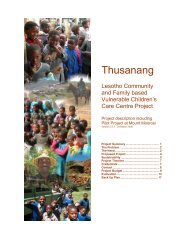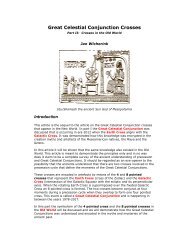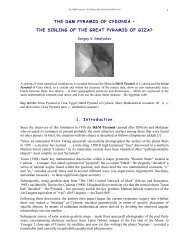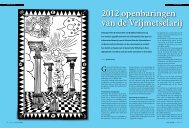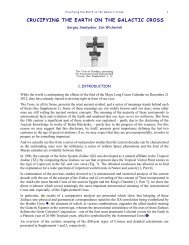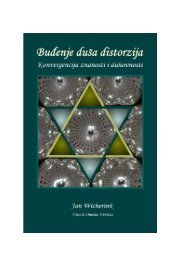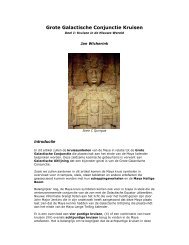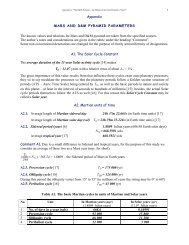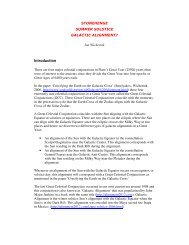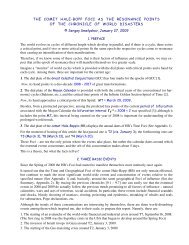Get a FREE Sampler PDF - Atlantis Rising Magazine
Get a FREE Sampler PDF - Atlantis Rising Magazine
Get a FREE Sampler PDF - Atlantis Rising Magazine
You also want an ePaper? Increase the reach of your titles
YUMPU automatically turns print PDFs into web optimized ePapers that Google loves.
ALTERNATIVE SCIENCE<br />
Can We<br />
See into<br />
the Future?<br />
A Scientist Looks<br />
for Evidence<br />
of Precognition<br />
• BY ROBERT SCHOCH, Ph.D.<br />
O<br />
n 21 October, 1966, at 9:15 in the<br />
morning, a huge pile of coal slag<br />
and debris, precariously perched on<br />
the side of a mountain and destabilized<br />
by underground water and rainfall,<br />
came crashing down on the Welsh town of<br />
Aberfan. When the tragedy was over and the<br />
final death toll computed, 144 lives were lost,<br />
most of them children attending the Pantglas<br />
Junior School, upon which the main<br />
part of the avalanche of black choking slurry<br />
descended. The Aberfan disaster was felt<br />
throughout Britain, perhaps among some<br />
people even before it actually occurred.<br />
Dr. J. C. Barker, a psychiatrist associated<br />
with Shelton Hospital in Shrewsbury, was on<br />
the scene of Aberfan the next day to help<br />
with the aftermath. Dr. Barker was also interested<br />
in psychical research, and it occurred<br />
to him that, given the violent and shocking<br />
nature of the Aberfan disaster, perhaps<br />
someone had had a premonition of the event.<br />
He made a public appeal for any such information<br />
through the media, and as a result received<br />
dozens and dozens of responses from<br />
people who claimed to have had precognitive<br />
experiences that, at least in hindsight, may<br />
have related to Aberfan. Dr. Barker carefully<br />
researched the best of these through interviews<br />
and seeking out corroborative evidence,<br />
and found nearly two dozen reputed<br />
precognitive experiences that could be independently<br />
confirmed by witnesses as having<br />
occurred before the Aberfan disaster.<br />
As an example of just one such person<br />
with apparent precognitive knowledge of the<br />
event we can cite Mrs. Constance Miller who<br />
“saw” the disaster about a day or so before it<br />
happened. Seven witnesses could testify that<br />
Mrs. Miller had related her premonition to<br />
them before the event. In her own words<br />
(quoted in Archie Roy, A Sense of Something<br />
Strange, 1990, p. 129), “First, I ‘saw’ an old<br />
school house nestling in a valley, then a<br />
Welsh miner, then an avalanche of coal hurtling<br />
down a mountainside. At the bottom of<br />
this mountain of hurtling coal was a little<br />
boy with a long fringe looking absolutely terrified<br />
to death. Then for a while I ‘saw’<br />
rescue operations taking place. I had an impression<br />
that the little boy was left behind<br />
and saved. He looked so grief-stricken. I<br />
could never forget him, and also with him<br />
was one of the rescue workers wearing an<br />
unusual peaked cap.” Mrs. Miller was not<br />
from Aberfan, and the argument that she<br />
had a personal interest in, and subconscious<br />
worries about, the slag pile as a potential<br />
threat does not apply. Very importantly, as<br />
we will discuss below, Mrs. Miller reported<br />
that, after the event, she recognized on a television<br />
program covering the Aberfan disaster<br />
the little boy and the rescue worker she<br />
“saw” so vividly in her premonition.<br />
For thousands of years, going back to the<br />
Biblical prophets and the classical oracles of<br />
ancient times (and probably much earlier)<br />
there has been a belief that at least some<br />
gifted people can gain glimpses of the future.<br />
The Greeks regularly consulted their oracles,<br />
such as that of Apollo at Delphi, and all cultures<br />
seem to have their methods of divination,<br />
whether it be the inspection of the entrails<br />
of animals, gazing into a crystal ball,<br />
looking at patterns among tea leaves, or consulting<br />
the Tarot or I Ching.<br />
In the book of Genesis it is recorded that<br />
Art, after the manner of<br />
Kirlian photography<br />
Joseph correctly interpreted pharaoh’s precognitive<br />
dream (seven fat cows eaten by<br />
seven lean cows, meaning there would be<br />
seven good years of harvest followed by seven<br />
years of famine). Daniel, in the book named<br />
after him, interpreted King Nebuchadnezzar’s<br />
dream of a great image or statue and<br />
a tree hewn down to indicate that the king<br />
and his kingdom would be destroyed, as was<br />
the case. St. John, in what is commonly referred<br />
to as the Book of Revelation, or The<br />
Apocalypse, relates many prophecies that appear<br />
to refer to the End Times. The Four<br />
Horsemen of the Apocalypse, found in<br />
chapter 6, have household name recognition.<br />
Might these events yet unfold?<br />
Closer to our own times, perhaps the<br />
greatest (or at least most famous) seer of the<br />
last five centuries is Nostradamus (Michel de<br />
Nostredame, 1503-1566). Trained as an astrologer<br />
and physician (he was very successful<br />
at treating outbreaks of the plague in<br />
southern France), he was heavily steeped in<br />
Jewish mysticism. To this day admirers and<br />
detractors argue over the accuracy of his<br />
forecasts. It seems clear, however, that in his<br />
own lifetime Nostradamus had achieved a<br />
Continued on Page 67<br />
40 ATLANTIS RISING • Number 71 Subscribe or Order Books, DVDs and Much More!



